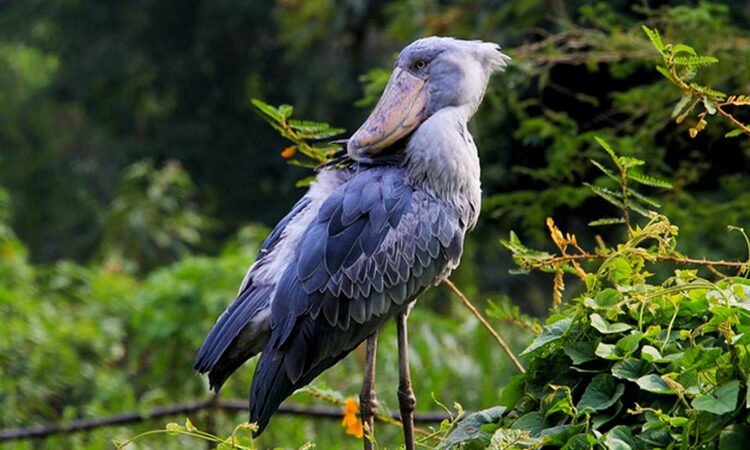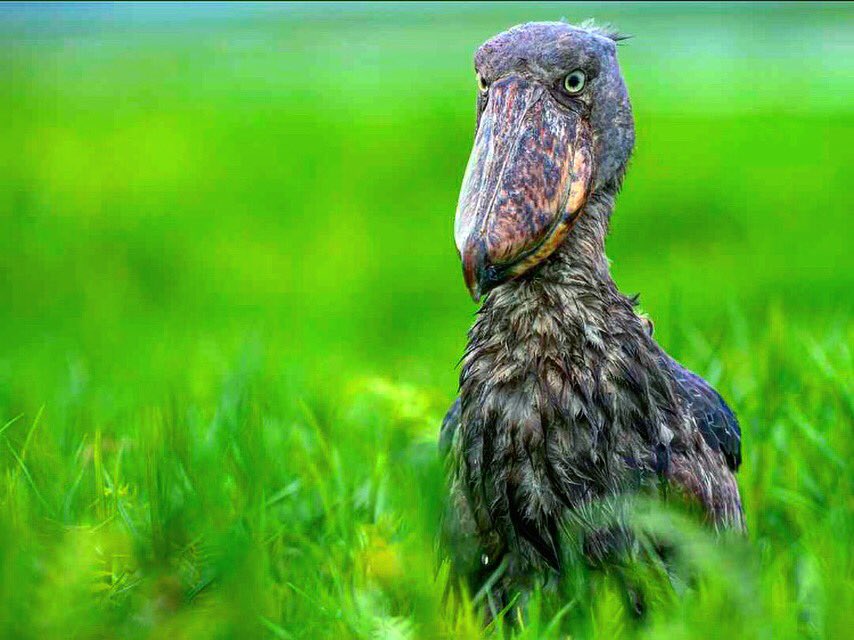Birding in Mabamba wetlands is among the activities to do during tours on Lake Victoria where the wetlands are located. Tourists visiting Entebbe and interested in seeing the various bird species visit the Mabamba wetlands for an exciting birding adventure. There are over 260 bird species which are found around the wetlands which are papyrus swamps.

The Mabamba swamp is located on the northern shore of Lake Victoria and it is one of the Important Birding Areas of Uganda (IBA) and also a RAMSAR site. Of the 12 Lake Victoria biome species, 7 are found in the Mabamba wetland area.
To protect the Shoebill Stork, the Mabamba wetlands were made a RAMSAR site in 2006. The Shoebill Stork is one of the most sought after birds found in Uganda and at the Mabamba swamps which are also the breeding grounds for the Shoebill Stork.
Chances of seeing the Shoebill are high when visiting the Mabamba wetlands. Other destinations where the Shoebill can be spotted during birding tours in Uganda include the Lugogo wetlands in Zziwa rhino sanctuary and also the Nile delta in Murchison falls national park.
The Shoebill Stork is a unique bird because of its appearance and it has been described as a pre historic bird and is also known for being a solitary bird. It feeds on lungfish, as well as frogs, water snakes, snails and many other species of fish.
In only a few other destinations in Uganda can the Shoebill Stork be seen during Uganda birding tours around the country which makes it one of the rare bird species to see. Because of the available food for the Shoebill around the wetlands which is lungfish, there are higher chances of seeing the bird during safaris.
Birding in the Mabamba wetlands can be done around the papyrus swamps, around the landing site and also on the edge of the water.
Other bird species found at the Mabamba wetlands include the Blue Swallow, Papyrus Gonolek, Little bee-eater, Rufous-napped Lark, Goliath Heron, Yellow-throated Greenbul, Slender-billed Gull, Spur-winged Goose, Northern Brown-throated Weaver, African Pied Wagtail, Grey-headed Kingfisher, Yellow Billed Stork, Black-headed weaver, Yellow-backed Weaver, Spur-winged Lapwing, Pied King Fisher, Slender-billed Weaver, Grey-Headed Sparrow, Black Headed Gonolek, Fan-tailed Widowbird, Blue-headed Coucal.
There are also other bird species in the Mabamba wetlands including Mosque Swallow, Stripped Kingfisher, Long-Crested Eagle, White-faced Whistling-duck, Long-toed Lapwing, African Marsh Harrier, Violet-backed Sterling, Common Greenshank, Brown Snake-Eagle, Yellow Wagtail, Orange Weaver, Great Blue Turaco, Ross’s Turaco, Ashy Flycatcher, Grey Wagtail, Black-faced Rufous Warbler, Woodland Kingfisher, Black Crake, Black Heron, Grey Crowned crane, White winged Tern, Great Cormorant, Swamp Flycatcher, Lesser Stripped Swallow, African Darter, Malachite Kingfisher, Sooty Chart, Grassland Pipit, Red-bellied Paradise Flycatcher, Western Nicator, Scaly Francolin, Green Sunbird among others.
During the birding tour around Mabamba swamp, tourists use boats to explore the swamps in search for the different bird species. The boats also easily navigate the marshes found around the area where different birds can be spotted.
As early as 07:00 am, tourists set out for the bird watching tours around the Mabamba wetlands which can take a whole day or half day depending on the birds spotted and the preference of the birder engaging in the activity.
The morning hours are considered the best time of day to see the Shoebill as well as other bird species at the destination. Tourists can enjoy 1 day birding tours around Mabamba wetlands before continuing to other destinations in Uganda to see more bird species.
The locals hire out boats to tourists to engage in Shoebill tours and bird watching experiences around the Mabamba wetlands. There are also privately owned boats which can be used to search for the different bird species around the destination.
Apart from taking part in fishing, the locals also act as birding guides for tourists as they look out for the various bird species found around the Mabamba swamp. Tour operators also offer professional and experienced bird guides to accompany tourists for the birding tours in Uganda.
The cost of birding in Mabamba wetlands ranges between 50 USD per person to 120 USD per person depending on what is included in the price as offered by the tour operator planning the birding tour at the destination.
Apart from the various bird species found in the Mabamba wetland area, sitatunga antelopes can also be seen during tours around the destination. Many migrant bird species can also be seen around the swamps during some months in the year especially around November to April.

Canoe rides are also among the activities which tourists can engage in during tours around the Mabamba wetlands. The Nkima forest can also be visited during tours around the wetlands and enjoy seeing various bird species as well as wildlife species such as monkeys.
Tourists can also visit the villages around the islands of Lake Victoria and interact with the locals, try out local food, go craft shopping and get to know more about their way of life and culture during community tours.
When visiting the Mabamba wetlands, tourists can stay at the Nkima forest lodge or at the hotels in Entebbe. For those staying in Entebbe, it is recommended to leave early and enjoy a morning boat ride on Lake Victoria on the way to the wetlands to enjoy the birding experience.
Best time for birding in Mabamba wetlands
The best time to engage in birding in the Mabamba wetlands is during the months of March, October, and November and also in September. During this time of the year, migratory bird species can also be seen around the wetlands.
Birding tours can however be done throughout the year to search for the different birds found at the destination.
How to get to Mabamba wetlands
The Mabamba wetlands can be accessed from Entebbe and tourists can proceed to Nakiwogo landing site where a ferry is available to take you across Lake Victoria to the point where the birding tour can start which is the Kasanje landing site.


